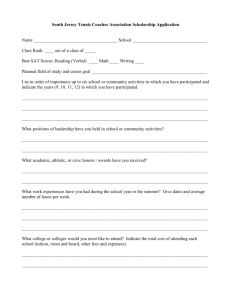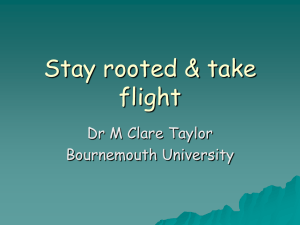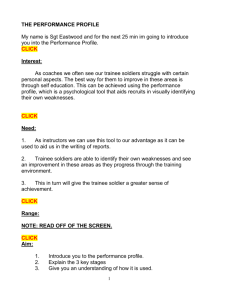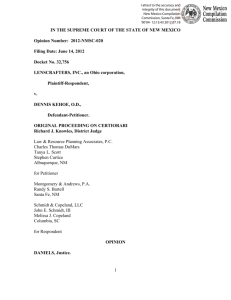Description, rationale and evaluation of innovative service for
advertisement
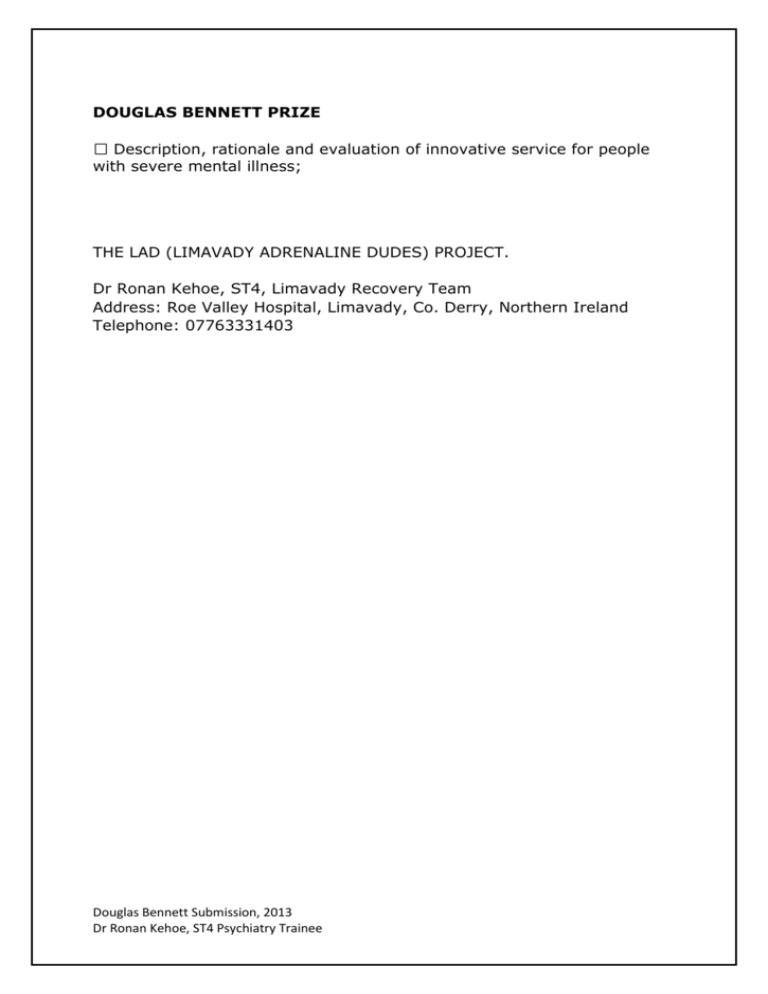
DOUGLAS BENNETT PRIZE Description, rationale and evaluation of innovative service for people with severe mental illness; THE LAD (LIMAVADY ADRENALINE DUDES) PROJECT. Dr Ronan Kehoe, ST4, Limavady Recovery Team Address: Roe Valley Hospital, Limavady, Co. Derry, Northern Ireland Telephone: 07763331403 Douglas Bennett Submission, 2013 Dr Ronan Kehoe, ST4 Psychiatry Trainee THE LAD (LIMAVADY ADRENALINE DUDES) PROJECT. UNOFFICIALLY SPONSORED BY NESTLE YORKIE BAR: IT’S NOT FOR GIRLS! Dr Ronan Kehoe, Limavady Recovery Team Description According to the Strategic Framework for Mental Health “Much psychological and emotional distress can be resolved by the imaginative use of generic services.” (National Framework for mental health and well-being, 2012). With this in mind, in August 2012 after a huge effort we applied to CLEAR (An Integrated Community Development Project providing mental health & emotional well-being services in the west of Northern Ireland) and were awarded £3800 to embark on our current innovative, creative and ground-breaking LAD (Limavady Adrenaline Dudes) project. Our programme targeted a population of our Recovery patients known to be less likely to engage with mental health services (Killaspy and Halloway, 2009): young (18-30yrs), male, severe and enduring mental illness. Rather than delivering traditional methods of mental health care that are nationally known by evidence to be unsuccessful, we decided to implement a novel and fresh, nontraditional approach to promote positive mental health. We therefore imaginatively tailored a service, specific to the individual needs of this clientele, and adopted a non-traditional delivery of positive mental health by constructing and completing a 14 week activity programme of high intensity, adrenaline arousing activities including zorbing, hovercrafting and paintballing. However remaining at the core of the project was the traditional recovery ethos: promoting a positive journey through social inclusion; building a life of hope, opportunity, personal control and partnership beyond mental health. With the resultant shift of focus on improvement in function, rather than symptoms. (Killaspy and Halloway, 2009). This ultimate design was in keeping with the new government proposal for patient involvement and choice: “no decision about me, without me!” (Government proposal of patient involvement and choice, 2012). The Recovery team staff supported the construction, delivery and development of this weekly programme and consideration was given to breaking the barriers of current social stigma: staff attending in own clothes and participating in activities which out of personal comfort zones; the use of private bus hire, not hospital transport; and, promoting patient preference and choice, selecting activities that would generally appeal to the young, males in the community. Douglas Bennett Submission, 2013 Dr Ronan Kehoe, ST4 Psychiatry Trainee Rationale: The rationale of the project was through our primary aim: to recognise, revise and reinforce generic qualities that promote positive mental health through a recovery ethos on a background provision of holistic care: communication, team work, problem solving, confidence building, social inclusion, patience, distraction, daytime routine and structure whilst highlighting the universality of mental illness. The ultimate goal would be the promotion of autonomy, independence and ownership; creating preferences and choice through positive partnerships. We aimed to improving users’ experience of care by provision of a community-based service for a vulnerable community cohort by: Meeting the specific needs of the individual participants (by nontraditional delivery); Promotion of positive mental health and the universality of mental illness; Increasing social inclusion; Psycho-education and reduction of stigma; Promotion physical activity to: improve mental health; for natural release of endorphins; as a distraction from negative acts/ thought; and, for general physical health awareness; Access to an intensive intervention with trained healthcare staff: training of more positive and natural coping mechanisms; creation of an individualised mental health first aid box/ crisis plan; increasing awareness and forming links with local groups; Encouraging carers support and involvement: through user involvement and captured in carer’s assessments. This positively impacts on attendance and participation and crisis plans and first aid boxes are encouraged to be shared. Evaluation: Quantitiative We collected and employed a variety of measurement tools. Quantitatively we used MoHost, (Parkinson, Forsyth and Kielhofner, 2006) a validated tool to assess global occupation participation. This tool measures motivation for occupation, pattern for occupation, communication and interaction skills, process skills and motor skills. Baseline and weekly scores were taken both subjectively and objectively. Through retrospective analysis they showed a significant improvement in global occupational function through all domains (table 1 and graph 1). Further statistical analysis would indicate that the mode before intervention was grade A, Allows Occupation, but this had improved to grade F, Facilitates Occupation, post-intervention. Similarly the median pre-intervention was A, Allows Occupation, and this had improved to F, Facilitates Occupation, post-intervention. Advanced statistical analysis using paired t tests show that the changes in the grades from the intervention are statistically significant, i.e. due to the intervention, rather than due to chance. (Table 2) Douglas Bennett Submission, 2013 Dr Ronan Kehoe, ST4 Psychiatry Trainee Table 1 showing MoHOST scores before and after intervention MoHost Scale BEFORE INTERVENTION Global Score (%) AFTER INTERVENTION Global Score (%) F Facilitates Occupation 39 56 A Allows Occupation 40 34 I Inhibits Occupation 19 10 R Resists Occupation 2 0 Graph 1 showing MoHOST scores before and after intervention 60 % Score 50 40 30 After 20 Before 10 0 Facilitates Allows Restricts Inhibits MoHOST Scale Table 2 showing paired t tests of MoHOST grade improvement from the intervention Paired Differences 95% Confidence Interval of the Difference Mean -4.250 Std. Deviation 4.528 Std. Error Mean 1.601 Lower -8.035 Upper -.465 t -2.655 7 Sig. (2tailed) .033 1.043 7 .332 3.763 3.067 7 .018 1.394 1.323 7 .227 Pair 1 F:Before – F:After Pair 2 A:Before – A:After 1.625 4.406 1.558 -2.058 5.308 Pair 3 I:Before – I:After 2.125 1.959 .693 .487 Pair 4 R:Before – R:After .500 1.069 .378 -.394 Douglas Bennett Submission, 2013 Dr Ronan Kehoe, ST4 Psychiatry Trainee df Qualitative: These results are mirrored in qualitative data of: users, who personally attribute their positive outcomes in terms of friendships, communication, social skills, interaction and habituation (“it’s helped me make friends and realise I’m not the only one dealing with this stuff,” and “It takes you out of your head for a while.”); and, staff, who support the improvement in similar areas of mental health, social functioning, medication compliance as well as physical health and monitoring awareness. Personal Outcomes: Through this experience, I am proud to affirm my role as a team member but also as a manager and a leader: being able to conceptualise a deficiency within the current service provision and creatively designing a project around it. It has given me the opportunity to manage not only a team of professionals but also external providers, patients and a budget! Team work was a core factor of this project: working within a capable and eager team was a foundation factor for success and the resultant hugely positive impact on these relationships and the identification and development of personal qualities were unremarkable. But for me, assessing and treating individuals, outside of my comfort zone of a clinic room, in an unusual environment that at times involved frightening activities that challenged my own personal boundaries was perhaps one of the most rewarding outcomes. But ensuring the delivery of the project with roots firmly seated in a recovery ethos and with the ultimate human outcome of viewing our users as individuals and not patients will be a memory that will inspire and define my clinical practice for the fortunate length of my career. Additional outcomes: Other positive measurements of the project include: being cost-effective, four hour contact with two MDT staff, weekly for 14 weeks; the increase in compliance with medication preventing drug wastage; decrease in the use of drugs and the wider social financial impact of drink/ drug misuse; all users have had reduction in key-worker input and none have entered into “crisis” therefore no need for further crisis service involvement or multi-agencies and indeed NO hospitalisations. But strikingly, can a financial cost be placed on positive mental health? Furthermore our project is designed as a catalyst, to move patients through their recovery journey and the Bates traffic lights model (Bates et al 2006) of social inclusion. Encouraging onward involvement with e.g. leisure centre leads to maintenance of users’ positive mental and physical health through their recovery journey (pacing, social inclusion, journey) The Public Health Agency (PHA), Northern Ireland have also recognised the hugely positive outcomes of our project and have kindly invested a substantial amount of money in March 2013 to continue this project in our own area and to look at its expansion within our Trust and hopefully regionally! Douglas Bennett Submission, 2013 Dr Ronan Kehoe, ST4 Psychiatry Trainee Conclusion: Knowing that a huge target group, young men with SMI, are known to be difficult to engage with resultant mental health disability, we have adopted a non-traditional delivery of the traditional message of positive mental health within the recovery ethos. We have run this project for 14 weeks and have already seen significant results: quantitative analysis of occupational function shows global improvement, qualitative analysis of both user and staff data show an even more significant improvement in the physical and mental health of the users. The ability to initiate and maintain engagement with this group of users is extremely commendable but to proudly say that we can improve medication compliance, reduce stigma, provide psycho-education, promote positive mental health and ultimately social inclusion, using the recovery ethos as its foundation is indeed, in keeping with the Northern Ireland PHA 2013 agenda of “Delivering Excellence, Supporting Recovery.” Douglas Bennett Submission, 2013 Dr Ronan Kehoe, ST4 Psychiatry Trainee
